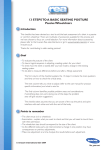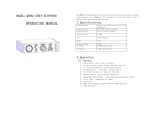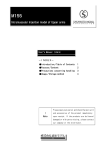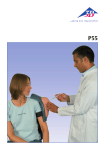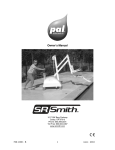Download User`s Manual Port - “Body in a Box”™ - 5010
Transcript
Port - “Body in a Box”™ - 5010 User’s Manual 308 South Sequoia Parkway | Canby, Oregon 97013 USA ph. 503.651.5050 | fax 503.651.5052 | email [email protected] | www.vatainc.com Thank you for purchasing VATA’s Port - “Body in a Box”™ Model 5010. This compact, lightweight and easy to use model is great for teaching, training, skills assessment and competency verification. Please carefully read the entire User’s Manual before using the model to insure you understand the proper care and use of this device. This will also avoid situations that may not be covered by the warranty and enable you get the maximum benefit from this model. This model is made with VATA’s custom developed material, Dermalike II™. This material, when used according to the instructions, offers many unique and improved properties. Some of these properties are: • Does not have an “oily” surface. • Reduced drag/resistance on the needle when accessing - you no longer have to force the needle through tough material, which results in a much more realistic experience. • Improved tear resistance, extending the useful life of the product. • Feels and palpates like human tissue for a more realistic learning experience. • Stain resistant. Note: Do not place the Dermalike II™ Tissue Flap in contact with products made of vinyl or PVC for prolonged periods of time as the chemicals in them will cause degradation of the material. Port - “Body in a Box”™ Model 5010 Contents 1 2 3 4 5 6 7 8 9 10 11 12 13 2 Tissue Block Tissue Flap of Dermalike II™ Port - Shown inverted in storage position Round Insert of Dermalike II™ Used to Simulate a “Tipping” Port Round Insert of Dermalike II™ Used to Simulate a “Floating” Port Simulated Blood Reservoir Bag with 35cc of “Blood” – See Photo 8 - Not visible as contained in tissue block Needle-guard – See Photo 8 Not visible as contained in tissue block Included supplies – See Photo 2 labeled Included Supplies 3/4” Right Angle Huber Needle with 8” Extension Set 1” Right Angle Huber Needle with 8” Extension Set (1” needle has a red “X” on the snap clamp for easy identification) 3 Packs of Lubricating Gel Used with the “Floating” Insert 5cc Syringe Supplies Container www.vatainc.com 5 2 4 13 1 Photo 1 – Port - “Body in a Box”™ Model 5010 3 13 10 12 9 11 Photo 2 – Included Supplies www.vatainc.com 3 Tissue Block and Tissue Flap Accessing of the port can be done in the carrying case or with the tissue block and skin flap removed from the case, see Photo 3A & 3B. The port can be positioned anywhere on the surface of the tissue block for accessing. This is currently the only model that comes with a real port for practicing. With this model, it is possible to simulate accessing a “tipping” port, a “floating” port and a normally placed port. Successful access is confirmed by a “blood” return, as the unit has its own fluid reservoir bag neatly tucked inside the tissue block. The reservoir bag is supplied with 35cc of simulated blood and has a maximum capacity of 60cc. Later in this manual, the technique to remove or add air or fluid in the bag is addressed. Photo 3A – Accessing port in case There are two round inserts that can be used to simulate difficult accessing placements, which is beneficial when the model is used for skills’ or competency assessment. To vary the experience, these two inserts are interchangeable. In addition, the tissue block can be rotated 180 degrees, with the port catheter entering the tissue block at the bottom instead of the top. This orientation would change the position of the inserts to the opposite side for an added variation. Photo 3B – Accessing port out of case The tissue flap has two thicknesses - half of the flap is 1/4” thick and the other half is 1/2” thick. The 1/4” side will approximate the feel when palpating a port at an average depth. The 1/2” side will approximate the feel when palpating a deeply placed port. There are port placements that are closer to the skin surface, however this model does not address accessing these as they are more easily visualized and accessed. There are two different length right angle Huber needles supplied with your model - a 3/4” for use when accessing the 1/4” thick side of the tissue flap and a 1” for use when accessing the 1/2” thick side. There is a red “X” on the snap clamp of the 1” needle for easy identification. Replacement Huber needles are available from VATA. See Replacement Parts on the back page of User’s Manual. 4 www.vatainc.com The insert used to simulate a “tipping” port has a deep, long recess. The port is placed in the insert, as shown in Photo 4, and the tissue flap is placed over the port. When palpating for the port, the feel will be similar to that of a “tipping” port. See Photo 4. When using the dished/concave insert, liberally apply the supplied Photo 4 – Round insert to simulate lubricating gel to the top and a “tipping” port bottom of the port, place the port on the insert and cover with the tissue flap, as shown in Photo 5. When the port is palpated, the feel will be that of a “floating” port or one that was placed in adipose tissue or has lost a couple of anchoring sutures. The port will slide around as you try to palpate it and a three-finger technique may be used to stabilize the port as you access. The gel cleans up well with soap and water. Replacement packets are available from VATA. See Replacement Parts on the back page of User’s Manual. Remember that either the 1/2” thick or the 1/4” thick side of the tissue flap can be utilized with the difficult inserts described above. Photo 5 – Round insert to simulate a “floating” port Note: It is important that the port be inverted and returned to the recessed storage area molded in the tissue block, see Photo 6, when the model is not in use as storage of the port in any other position can cause a permanent deformation in the Dermalike II™ tissue flap. Should this happen, move the port to the proper storage position. Over the next 72 hours you will see most of the improvement that is possible. Photo 6 – Correct storage position for port www.vatainc.com 5 “Blood” Reservoir Bag The model is supplied with a simulated blood reservoir bag, containing 35cc of fluid which is positioned inside the tissue block. The reservoir bag has a white needle-guard attached to the top of the bag to minimize the chance that a needle that missed the port would puncture it, causing a leak. In the unlikely Photo 7 – Reservoir bag removal event this did occur, remove the bag, drain it, and order a replacement reservoir bag. See Replacement Parts on the back of the User’s Manual. To remove the “blood” reservoir bag, gently separate the opening on the top of the model where the port catheter tubing appears to enter the tissue block. With your index finger and thumb, grasp the bag and needle-guard and gently pull the bag out. See Photo 7. Photo 8 Reservoir bag with excess air Note: The port and catheter are attached to the reservoir bag and should remain attached to the reservoir bag as you remove it. Under normal circumstances the reservoir bag will not require care, but there are two conditions that will require attention. If a bulge or hardness is observed on the tissue block surface, or if you observe air in the syringe when withdrawing fluid, the fluid bag will need attention. Remove the bag as outlined before. Once removed there are several functions that can be performed with the fluid bag out of the model. If the fluid bag is “bloated” due to air or additional fluid being infused into it, the bag will need to be partially drained. Photo 9 – Correct orientation of reservoir bag for air/fluid removal 6 With the syringe plunger pushed www.vatainc.com all the way in, attach the syringe to the Huber needle extension set and access the port. Holding the accessed port in one hand, allow the bag to hang below, as shown in Photo 9. This will position all the air at the top of the bag permitting easy removal when aspirating. Draw back on the syringe plunger to aspirate the air or fluid. Once the syringe is full of excess air or fluid, close the snap clamp on the extension set, disconnect the syringe and expel the air or fluid. Push the syringe plunger all the way to the bottom before reattaching to the extension set. This procedure may need to be repeated several times to remove all the air or fluid. It may be beneficial to use a larger syringe if the volume that needs to be added exceeds the capacity of the 5cc syringe supplied with the model. The goal is to remove all the excess air or fluid until there is only 35cc of fluid in the bag. See Photo 10 – Bag after removal of excess air Photo 10. Should it become necessary to add “blood” to the reservoir bag, this can be accomplished by filling a syringe with fluid. Attach a pre-filled syringe to the extension set, access the port with the Huber needle and gently infuse. Take care not to infuse air as this will collect in the reservoir bag and be observed later when withdrawing fluid. The bag should be filled to 35cc of fluid. Note: The bag is supplied with 35cc of fluid. The maximum capacity of the bag is 60cc. This allows for some expansion in volume of the bag. Having more than 60cc in the bag should be avoided as this could result in leaking. The bag can then be replaced into the tissue block, routing the port catheter up through the small channel. Be sure to position the needleguard on the fluid bag, toward the top of the tissue block, to protect the bag from needle punctures. www.vatainc.com 7 All parts on this model are available individually. Product # Description Price 5010 Port - “Body in a Box”™ of Dermalike II™....................... $184.00 5011 Port - “Body in a Box”™ Darkly Pigmented....................... $184.00 5011 Replacement Parts 5020 Skin Flap 6 7/8” X 5 1/4” of Dermalike II™.......................... $ 69.00 5021 Tissue Block 6 7/8” X 5 1/4” ............................................... $ 77.00 5022 Round Insert of Dermalike II™ to Simulate “Tipping” Port.... $ 21.00 5023 Round Insert of Dermalike II™ to Simulate “Floating” Port .. $ 21.00 5024 Simulated Blood Reservoir Bag with Needle-guard............. $ 24.00 5025 3/4” 20g Right Angle Huber Needle with 8” Extension Set (1 doz.)..$ 20.00 5026 1” 20g Right Angle Huber Needle with 8” Extension Set (1 doz.).$ 20.00 (1” needle has a red “X” on the snap clamp for easy identification) 5027 Lubricating Gel Packs (1 doz.)............................................. $ 9.00 1491 Simulated Blood - One Quart - New Stain Resistant........... $12.55 1494 Simulated Blood - One Gallon - New Stain Resistant.......... $18.95 2491 Simulated Blood - One Quart - New Stain Resistant Same Viscosity as Real Blood............................................. $16.20 2494 Simulated Blood - One Gallon - New Stain Resistant Same Viscosity as Real Blood............................................. $26.80 0406 Practice Port (IVAD)............................................................. $69.00 308 South Sequoia Parkway | Canby, Oregon 97013 USA ph. 503.651.5050 | fax 503.651.5052 | email [email protected] | www.vatainc.com










